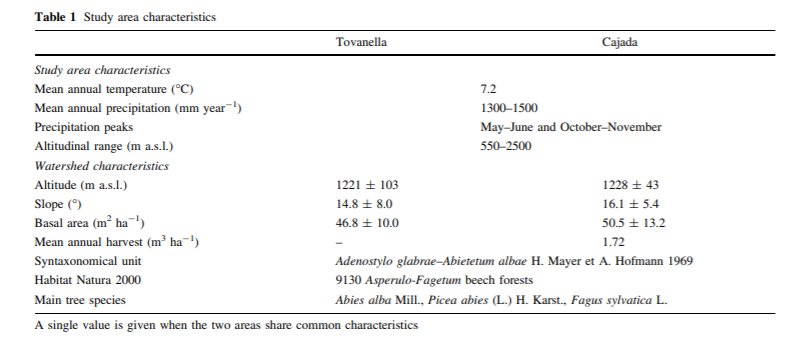1/ Its a Beetle day in todays #rewildingscience paper review. As we look at the response of Beetle communites to forestry abandonment in the Eastern Alps. The paper sheds light on some of the benefits for invertebrate communites that reduced management can have #rewilding 

2/ Understanding the role of forestry in changes to biodiversity is crucial in applying conservation measures. This paper investigated whether changes have occurred in species richness, abundance and composition of beetle communities due to cessation of forest management
3/ Ten managed and ten abandoned forest plots in two watersheds located in the north-eastern Italian alpine region were surveyed, sharing a common history of use, climate regimes, stand structure and topography.
4/ In the Tovanella watershed, forestry practices were abandoned more than 50 years ago, while forest management still continues in the Cajada watershed. Ground beetles, and longhorn and bark beetles were collected with pitfall and flight-intercept window traps, respectively 

5/ In total, 19 ground beetle, 15 longhorn beetle and 17 bark beetle species were recorded. A higher rarefied number of carabid species were collected from the managed compared with the abandoned watershed (Cajada = 18.0, Tovanella = 12.8, n = 1682 individuals).
6/ No difference existed in the rarefied number of longhorn (Cajada = 6.0, Tovanella = 5.7, n = 8 individuals) and bark beetle (Cajada = 6.0, Tovanella = 6.0, n = 166 individuals) species collected from these watersheds.
7/ A total of 4341 ground beetle, 47 longhorn beetle and 1515 bark beetle individuals were collected, with significantly more ground and bark beetles collected from the Tovanella than from the Cajada watershed. Longhorn beetle abundances did not differ between the watersheds
8/ The results found that Carabid beetle communities& species responded mainly to soil moisture, understorey vegetation & deadwood. Several carabid species & species groups responded negatively to increasing soil moisture, but positively to increasing understorey vegetation cover 





9/ Saproxylic species and communities were shown to respond primarily to naturally occurring deadwood, crown cover, tree species richness and volumes. These results deonstrate that several habitat features shape beetle assemblages in silver fir forests. 





10/ Moisture was found to have a negative effect on almost all ground beetle species and species groups analysed, while all species and the community responded positively to an increase in the cover of understorey vegetation and to some degree to tree cover 

11/ Interestingly course woody debris negatively affected some carabid species, such as the wingless Pterostichus burmeisteri and Carabus linnaei which may have resulted from CWD hampering beetle movements on the forest floor or affecting their catch rate.
12/ At the community level, however, responses to deadwood were stronger. Higher values for logs were associated with the abandoned watershed (Tovanella) and its associated longhorn and bark beetle communities, while also snags were positively related to the bark beetle community 

13/ In the Cajada watershed, stumps—indicating relatively recent forestry operations—were positively related to the bark beetle community 

14/ The study found that volumes of naturally occurring logs and snags were higher in abandoned than in managed plots. These habitat features influenced the composition of ground, bark and longhorn beetles and influenced the abundance of several ground and bark beetles. 





15/ Furthermore, management cessation is positively related to crown cover, which the study found to have a positive influence on T. domesticum and also influenced bark beetle composition.
16/ The paper found that effects of forest management on ground beetles are consistent with studies that have highlighted the influence of forestry, confirming that forest specialist species are favoured by forestry abandonment but also, in this case, generalist species
17/ The paper concludes by suggesting that these results represent preliminary evidence for setting aside forest areas for maintaining and restoring biodiversity in forested landscapes that have been subjected to centurylong human alterations
18/ This paper while small in sample goes a long way to showing the benefits of messyness and reduced or complete cessation of management in forestry areas can have on beetle communities and assemblages.
19/ It point out towards the end that the debate around abandoning grassland areas is a completley seperate conversation to forestry. But this paper along with others do pose a question over the extent and methods to which nature reserves/forestry should be managed
20/ Other research on the aethetics of forested areas where deadwood is allowed to fall, talk about the positive sense of wildness is creates in us, so potentially a bit more mess and bit less management in the right places could be a good result for biodiversity and people.
21/21 What are people thoughts on this? beetle communities are one part of a larger discussion about how tidy and how managed our nature reserves/foresty should be, and what should we manage them for? #rewilding #rewildingscience #forestry #conservation
The full paper can be found here: link.springer.com/content/pdf/10…
Let us know your thoughts #rewildingscience #rewilding #conservation #forestry #beetles
Let us know your thoughts #rewildingscience #rewilding #conservation #forestry #beetles
• • •
Missing some Tweet in this thread? You can try to
force a refresh









